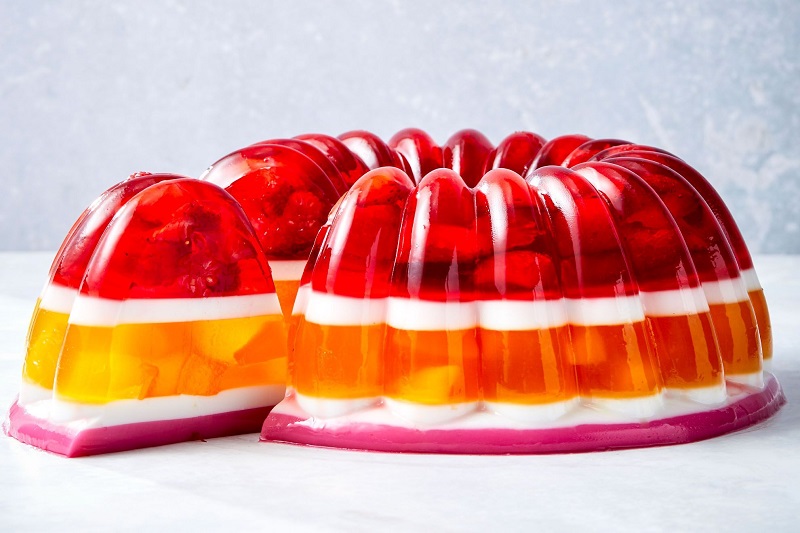May. 24, 2022
1 Application in jelly production
Food thickeners often use two or more synergistic effects in jelly production and processing, so as to achieve the best effect required by jelly. Gellan gum is an extracellular linear polysaccharide synthesized and secreted by Pseudomonas spp. during the pure fermentation of carbohydrates. Due to its good clarity and sufficient thermal stability, gellan gum is used in combination with xanthan gum to produce instant dessert gels. Deacylated gellan gum is used to improve moisture retention, flavor release, and storage stability of puddings, and to reduce syneresis.
Metal cations play a key role in the gel formation process of gellan gum. The cation is directly connected to the carboxyl group on the polysaccharide molecule through the method of site-specific binding, thereby weakening the electrostatic repulsion between the double helix chains, which is very favorable for the formation of the "linking region".
Carrageenan is a natural seaweed polysaccharide, a hydrophilic linear heterogeneous polysaccharide containing sulfate groups, linked by 1,4-β-D-galactopyranosaccharide and 1,3-α-D-galactopyranosaccharide as the basic skeleton It can be extracted from the cell wall of red algae. During the slow cooling process of carrageenan after heating, the shape of the molecule gradually changes from the initial coiled shape to the helical shape, and finally from a single helix to a double helix, and a three-dimensional network structure is formed at this time.
When carrageenan can form a thermally reversible gel at a lower concentration, the carrageenan at this moment has better transparency and can improve the appearance of jelly. Carrageenan is the most common thickener in jelly production and has been used in food formulations synergistically with other thickeners. When carrageenan is compounded with locust bean gum, gelatin, xanthan gum and gum arabic, the gel strength and elasticity can be significantly improved.

2 Application in yogurt
Thickeners can increase the viscosity of yogurt, stabilize the properties of yogurt, prevent the precipitation of whey, and effectively improve the texture and taste of yogurt products. When propylene glycol alginate and modified starch are used as thickeners at the same time, they can play a good synergistic effect. is 1.20%.
In the process of yogurt production and processing, adding 0.2% propylene glycol alginate can increase the overall water retention capacity of the product by 10.9%, effectively preventing the precipitation of whey. When 0.2% propylene glycol alginate (W/W), 0.3% sodium carboxymethyl cellulose, 0.1% high ester pectin, 0.015% (W/W) sucrose ester are compounded and added as an acid milk beverage production and processing process At this time, the product stability and taste are the best.
Polydextrose is a good prebiotic. Fermentation in the intestinal tract can reduce the intestinal pH value from 7.24 to 6.44, which is beneficial to the growth and proliferation of probiotics such as lactic acid bacteria and bifidobacteria. During the production and processing of yogurt, polydextrose can enhance the dietary fiber content and enhance the taste of the product because it is still stable at low pH. In low-fat or non-fat products, it can effectively prevent the separation of water, improve its water holding capacity, and effectively improve the texture and taste of the product.
Studies have shown that when the amount of polydextrose in yogurt products is 1% (W/W), it can enhance the viscosity and sweetness of the product and make the product taste richer. Polydextrose can improve the vitality of other bacterial species in yogurt and effectively prolong the shelf life of yogurt.
When the added amount of polydextrose in yogurt products is 3% (W/W), it is beneficial to the fermentation of yogurt, improves the activity of lactic acid bacteria, reduces the precipitation of whey, and plays a key role in the tissue morphology of the product. The amount achieves the best curd effect, and the acidity and sweetness are moderate.
When 4% (W/W) polydextrose is added to the coagulated yogurt, the product has a delicate taste, moderate sweetness, significantly reduced whey precipitation, and good stability. And polydextrose can well retain the flavor of yogurt, extending its shelf life.
3 Applications in soft drinks
Sodium carboxymethyl cellulose is the most common thickener in acidic beverages, and can form high-viscosity solutions in water because it is easily soluble in water. Sodium carboxymethyl cellulose is most commonly used in milk due to its acid-resistant properties. Sodium carboxymethyl cellulose can effectively prevent the precipitation of casein and prolong the shelf life of dairy products. Sodium carboxymethyl cellulose can also improve the suspension stability of fruit and vegetable beverages, prevent the precipitation of beverages, and effectively maintain product stability and appearance.
Xanthan gum has the highest viscosity of natural gums and is soluble in cold water, and is widely used in the production of soft drinks. Aqueous solutions of xanthan gum have a typical pseudoplastic flow in which viscosity decreases when shearing force is present and viscosity recovers when shearing force disappears. Most gums are viscous unstable over a wide temperature range, while the viscosity of xanthan gum varies much less than other gums. Xanthan gum also has good salt tolerance, and will not be precipitated by the influence of salt when heated.
Xanthan gum is also used in pulp-based beverages and protein drinks to enhance the suspension of active ingredients such as casein. The pseudoplasticity of xanthan gum enhances the viscosity of beverages, making beverages thicker without stickiness. In addition, xanthan gum also has good compatibility, when used together with other thickeners, it will have a synergistic effect.
Previous: About Non-dairy Creamer